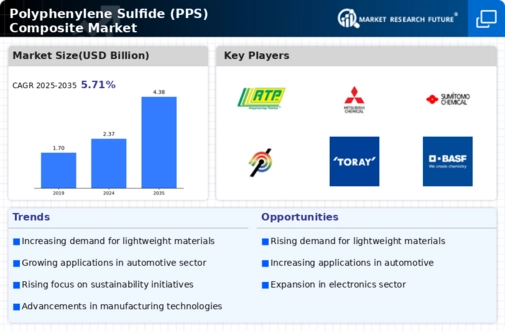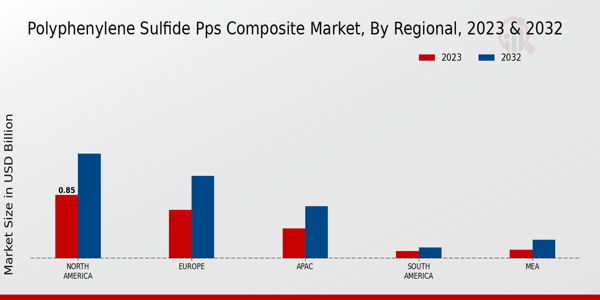Market Growth Projections
The Global Polyphenylene Sulfide (PPS) Composite Market Industry is poised for substantial growth, with projections indicating a market size of 2.37 USD Billion in 2024 and an anticipated increase to 4.38 USD Billion by 2035. This growth trajectory suggests a compound annual growth rate of 5.73% from 2025 to 2035, reflecting the increasing adoption of PPS composites across various sectors. The market dynamics are influenced by factors such as technological advancements, rising demand in automotive and electronics, and a growing focus on sustainability.
Increasing Focus on Sustainability
The Global Polyphenylene Sulfide (PPS) Composite Market Industry is witnessing a shift towards sustainability, driven by environmental concerns and regulatory pressures. Manufacturers are increasingly seeking eco-friendly materials that can reduce environmental impact while maintaining performance standards. PPS composites, known for their durability and recyclability, are becoming a preferred choice in various industries. This growing emphasis on sustainable practices is likely to contribute to the market's expansion, as companies strive to align with global sustainability goals and consumer preferences for greener products.
Rising Demand in Automotive Sector
The Global Polyphenylene Sulfide (PPS) Composite Market Industry is experiencing a notable surge in demand from the automotive sector. This growth is primarily attributed to the increasing need for lightweight and high-performance materials that enhance fuel efficiency and reduce emissions. PPS composites are favored for their excellent thermal stability and chemical resistance, making them ideal for automotive applications. As the automotive industry continues to evolve, the market is projected to reach 2.37 USD Billion in 2024, reflecting a robust demand for innovative materials that meet stringent regulatory requirements.
Expanding Applications in Aerospace
The Global Polyphenylene Sulfide (PPS) Composite Market Industry is benefiting from the expanding applications of PPS composites in the aerospace sector. The lightweight and high-strength properties of PPS make it an ideal material for aircraft components, contributing to fuel efficiency and overall performance. As the aerospace industry continues to innovate and seek materials that can withstand extreme conditions, the demand for PPS composites is expected to rise. This trend is indicative of the broader shift towards advanced materials in aerospace, further solidifying the market's growth trajectory.
Advancements in Manufacturing Technologies
Innovations in manufacturing technologies are playing a crucial role in the Global Polyphenylene Sulfide (PPS) Composite Market Industry. The development of advanced processing techniques such as injection molding and 3D printing is enhancing the efficiency and versatility of PPS composites. These advancements enable manufacturers to produce complex geometries and customized solutions that cater to specific industry needs. Consequently, the market is anticipated to grow significantly, with projections indicating a rise to 4.38 USD Billion by 2035. This growth underscores the importance of technological advancements in driving the adoption of PPS composites across various applications.
Growth in Electronics and Electrical Applications
The Global Polyphenylene Sulfide (PPS) Composite Market Industry is significantly influenced by the expanding electronics and electrical sectors. PPS composites are increasingly utilized in manufacturing components such as connectors, insulators, and circuit boards due to their superior electrical properties and thermal resistance. The ongoing trend towards miniaturization and the demand for high-performance materials in electronic devices are likely to propel market growth. As a result, the industry is expected to witness a compound annual growth rate of 5.73% from 2025 to 2035, indicating a strong future for PPS composites in this sector.























